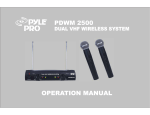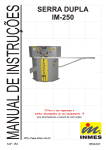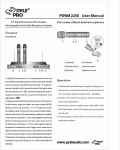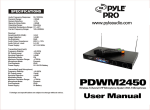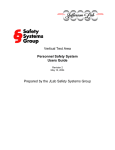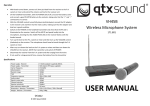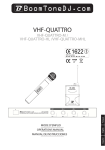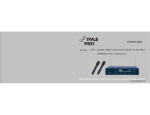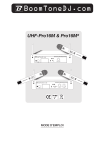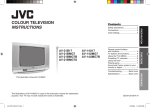Download PYLE Audio PDWM5300 User's Manual
Transcript
PDWM 5300 PDWM 5300 UHF PLL Diversity Wireless Microphone System w/ LCD UHF PLL Diversity Wireless Microphone System w/ LCD PDWM5300 OPERATION MANUAL PDWM5300 OPERATION MANUAL Thank you for buying the PDWM5300 Wireless System. Please read through these operation instructions so you will know how to operate your model properly. After you read it, put it away in a safe place for future reference. Avoid exposure of the system to rain or moisture. No user-serviceable parts inside the system. Refer all servicing to a qualified technician only. Handle the wireless system carefully, dropping or other shocks may cause failure. Avoid using the system where it may be subjected to heat, such as direct sunlight, Precautions Hand-held microphone Receiver Installation Trouble shooting Specifications near radiators or other heat sources. Should any liquid be spilt on the system, stop using it immediately. It may be possible to dry the system, but you should have it checked by a qualified technician before using it again. Take care with the main power adapter and lead. If damaged in any way, do not use the system and refer to a qualified technician for repair. Only use the system with the supplied components. Do not attempt to use with any other main power supply adapter . If the wireless system is not going to be used for a while, remove the battery to prevent leakage. In the event of electrolyte leakage inside the battery compartment, carefully remove the leakage with a damp cloth. Take care not to get battery electrolyte in contact with your skin, however if it does, wash your hands under a running tap. If electrolyte comes into contact with your eyes, seek medical advice immediately. Only replace the battery with the same or an equivalent type. Please dispose of old batteries in an environmentally friendly manner in accordance with the relevant legislation. Do not use any solvents to clean any part of the wireless system . 1 PARTS DESCRIPTION 1. 2. 3. 4. Mesh: cartridge inside Tube Power LED indicator Power and Mute switch: Switch on and off the microphone. Move the switch to middle position to mute the mic. 5. Battery compartment 6. Battery Cover 7. CH selector 6 + ON OFF + 1. Unscrew the battery cover at the end of the microphone. Install the provided 2 1.5V batteries, taking care to fit it with the correct polarity connected. 2. According to frequency Chart on the battery cover, adjust the CH selector to make the microphone to be the same frequency as receiver. 3. Check the battery by switching the microphone ON. The red LED will come on. This indicates correct operation. If the red LED is dim, this indicates the battery is low and should be changed. If the red LED does not come on at all, it indicates the battery is dead and should be replaced. ON DIP 1 2 3 4 OPERATION 7 FREQUENCY CHART CH00 CH01 CH02 795.2MHz 795.8MHz 796.4MHz CH08 800.0MHz CH03 CH04 797.0MHz 797.6MHz CH05 CH06 CH07 798.2MHz 798.8MHz 799.4MHz CH12 802.4MHz CH13 CH14 CH15 803.0MHz 803.6MHz 804.2MHz CH09 CH10 CH11 800.6MHz 801.2MHz 801.8MHz 2 PARTS DESCRIPTION CH00 795.2MHz 00dB AF 1. Power Switch: Turn on power switch, the display of LCD will illuminate. 2. Power LED indicator: Turn on power switch, this indicator will illuminate. 3. SET: Press once to adjust frequency by UP/DOWN buttons. Press again to exit. 4. UP: Channel UP 5. DOWN: Channel DOWN 6. LCD Display 7. Volume control 8. Antenna A and B 9. Balanced output 10. Unbalanced output 11. 12V DC IN OPERATION 1. Connect the antennas A and B. Make sure they are vertical. 2. Insert one end of included audio cable into "AF OUT" on rear panel, and the other end into "LINE IN" of amplifier or mixer. 3. Connect the power adaptor from DC 12V of receiver to a main power socket. 4. Switch on the receiver. The power indicator comes on. LCD display will displayed on LCD panel. illuminate. Press SET once, there will be a mark Now you can adjust frequency by UP/DOWN buttons. Press SET again to exit. Make sure the microphone and receiver to be of same frequency. 5. Switch on the microphone. A letter "A" or "B" will appear in the top right of the LCD, indicating the diversity reception. RF strength (in dB) is indicated in the bottom left corner of the display. When you speak into the microphone, AF signal will display on the bottom of LCD display panel. 3 Using the supplied audio cable, connect from the AF OUT jack socket to the LINE IN socket on amplifier. Alternatively, you can connect an XLR cable to the XLR balanced output. Connect the mains power adaptor from "DC 12V" jack to a suitable mains power socket. Installation Location: At least 3 ft. above ground level At Least 3 ft. away from wall MIC LINE MIC LINE MIC LINE MIC LINE MIC LINE 4 The on air indicator does not light up The wireless microphone is not turned on. The microphone receiver is not turned on. Turn on the microphone receiver and the connected audio equipment The microphone receiver is not connected properly. Turn on the microphone receiver and the connected audio equipment Frequency not set correctly. Make sure mic and receiver are set to the same frequency. The battery in the wireless microphone is weak. No sound The sound is distorted A howling noise heard from the speakers. 5 Turn on the wireless microphone Replace the battery. The microphone receiver is not turned on . The connected audio equipment is not turned on. The speakers/headphones. are not connected to the audio equipment. The battery in the wireless microphone is weak. Turn on the microphone receiver and the connected audio equipment. The AUDIO OUT on the receiver is not set correctly. Adjust the volume controls. The distance between the wireless microphone and speakers are too close. Move the wireless microphone away from the speakers or change the direction of the microphone. The battery in the wireless microphone is weak Turn on the audio equipment. Connect the speakers/ headphones Replace the battery. Replace the battery. A. Overall System Carrier Frequency: Frequency Stabilization: Dynamic Range: Total Harmonic Distortion: Frequency Response: Audio Output Level: Mix Type: UHF 795~805MHz less than 30ppm more than 90dB less than 0.5% 40hz~15khz 3dB separate type:0~ 400mV 0~ 200mV B. Receiver Power Supply: DC 12V Consume Power: 4W Signal/Noise Ratio: more than 90dB Image & Spurious Rejection: more than 80dB Border upon Channel Rejection: more than 80dB Receiving Sensitivity: 10dBuv(sinad=30dB) De-emphasis: 50us C. Transmitter Transmitting Power: Modulation Type : Max Deviation: Spurious Emission: Power Supply: 8.5mW FM,F3F 25KHz more than 40dB(with carrier) 3V 6







